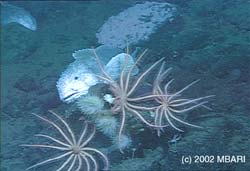Nurseries in the deep sea

A blob sculpin (Psychrolutes phrictus) peers over the edge of a boulder at the ROV Tiburon. This fish is guarding its eggs (which you can see in the background) along the Gorda Escarpment, off Northern California. Blob sculpin commonly grow to 60 cm (2 feet) in length. The animals on the rock are brisingid sea stars (with the feathery arms) and sea anemones. Image (c) 2002 MBARI
Exploring a deep-sea ridge off Northern California, scientists at the Monterey Bay Aquarium Research Institute (MBARI) have discovered a unique undersea nursery, where groups of fish and octopus brood their eggs, like chickens on their nests. This is the first time that marine biologists have directly observed any deep-sea fish brooding its eggs. It is also the first time that two different types of mobile deep-sea animals have been observed brooding together in the same area. Although the scientists do not know exactly why the animals prefer this one area, they believe that the nursery represents a new type of biological “hot spot” (an area of intense biological activity).
MBARI scientist Jeff Drazen presented these observations last week at the Deep Sea Biology Symposium in Coos Bay, Oregon. His research is also featured in the current (August 2003) issue of Biological Bulletin, which shows photographs of the brooding fish and octopus on its cover.
The undersea nursery was discovered and documented using MBARI’s remotely operated vehicle (ROV) Tiburon. Using video tapes from Tiburon dives, Drazen and colleagues found that each summer, blob sculpin (Psychrolutes phrictus) and deep-sea octopus (Graneledone sp.) gather together at the crest of the Gorda Escarpment, off Northern California.
“The sculpin nests look like large splotches of purple strewn across the surfaces of boulders,” says Drazen. “The parent fish is usually resting on the seafloor near or on top of the eggs. When I first saw this in the video, I was surprised because no one had ever documented such behavior in a deep-sea fish before.” Blob sculpin are typically about 60 cm (2 feet) long and shaped like large, flabby tadpoles. Drazen estimates that some sculpin nests may contain up to 100,000 eggs. The nursery area lies near the crest of an undersea rise, almost a mile below the ocean surface.
MBARI geologists first encountered these nursery areas in August 2000. While performing geological surveys with ROV Tiburon, they noticed that octopus and blob sculpin were common near certain cold seeps, where hydrocarbon-rich fluids seep out of the seafloor. When they returned to the region in 2001, they brought along biologists, who realized that the octopus were present in unusually large numbers. On one dive, the ROV also brought up a rock sample which was covered with eggs. It wasn’t until later, when Drazen watched videotapes of these dives, that he realized both the fish and the octopus might be brooding eggs. Intrigued, Drazen organized a third dive in July 2002, to count the animals and their eggs and to make more observations. The high densities of animals measured in certain areas convinced Drazen that these nurseries might qualify as biological hot spots.
Previously discovered biological hot spots in the deep sea, such as hydrothermal vents and the tops of seamounts, have been related to geological or topographic features that cause an increase the availability of food. The nurseries on the Gorda Escarpment may represent a totally different type of hot spot, where physical conditions particularly favor the development of eggs. Drazen is still not sure what aspect of the physical environment makes this spot so popular for brooding animals.
Whatever the key conditions may be, Drazen points out that these areas are critical habitat for the species involved. He and his co-authors are concerned that these undersea nurseries could be endangered by commercial trawling or long-line fishing. Such fishing has expanded into the deep sea as near-shore fish stocks have declined. For this reason, Drazen suggests that reproductive hot spots such as this might qualify as areas to be protected from fishing.
Finding one reproductive hot spot may also help scientists discover other such areas. But as Drazen points out, “Unlike hydrothermal vent and seamount communities, which persist for generations, reproductive hot spots may be seasonal and transitory. This makes such sites especially hard to find. We hope to learn more about why these animals aggregate on the ridge and use this information to narrow our search for other important nurseries in the deep sea.”
Media Contact
More Information:
http://www.mbari.org/news/news_releases/2003/nr05-drazen.htmlAll latest news from the category: Life Sciences and Chemistry
Articles and reports from the Life Sciences and chemistry area deal with applied and basic research into modern biology, chemistry and human medicine.
Valuable information can be found on a range of life sciences fields including bacteriology, biochemistry, bionics, bioinformatics, biophysics, biotechnology, genetics, geobotany, human biology, marine biology, microbiology, molecular biology, cellular biology, zoology, bioinorganic chemistry, microchemistry and environmental chemistry.
Newest articles

Largest magnetic anisotropy of a molecule measured at BESSY II
At the Berlin synchrotron radiation source BESSY II, the largest magnetic anisotropy of a single molecule ever measured experimentally has been determined. The larger this anisotropy is, the better a…

Breaking boundaries: Researchers isolate quantum coherence in classical light systems
LSU quantum researchers uncover hidden quantum behaviors within classical light, which could make quantum technologies robust. Understanding the boundary between classical and quantum physics has long been a central question…

MRI-first strategy for prostate cancer detection proves to be safe
Active monitoring is a sufficiently safe option when prostate MRI findings are negative. There are several strategies for the early detection of prostate cancer. The first step is often a…



